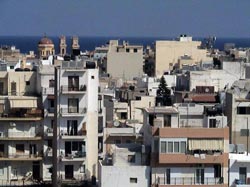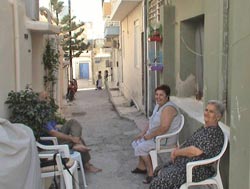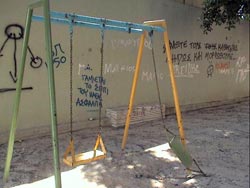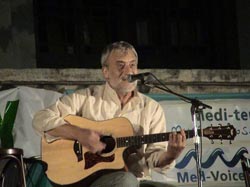Late in the afternoon I wander in the deserted streets and I feel as if I’m standing in the old town of Heraklion of many years past. When the ladies would put on their pearls and, arm-in-arm with their husbands, would take their afternoon promenades. When Kir-Kor – by the fountain of Morozini – couldn’t catch up with making cream filled pastries and cheese pies, or the so called bougatsa and tiropita, for all the people at the surrounding tables outside, or those just hanging out to watch the water spilling from the mouth of the four lions.
The photographers in the Eleftherias Square . . . the pigeons on the dome of Saint Mina’s Cathedral . . . the uniformed students from the All Girls High School . . . the aristocratic families of those times. On the other side, the boarding house in a gallery in Evans’ street, the boys with short haircuts, the grannies outside their homes in the neighbourhoods behind the elementary school “Anogeiano”. Hand-held fans trying to send away the southern wind. Babies crying in sweaty arms. The other view of the city. The slums. The day labourers. Long queues of people every Saturday night outside the cinema ” Astoria ” to watch Aliki Vougiouklaki.
 Heraklion is the city of contrasts. It has great beauty and great ugliness. Neighbourhoods with absolute quietness and others with deafening noise. Houses with families who share the same yard and apartment blocks where nobody knows who lives next door. Districts clean and tidy and others dirty and full of rubbish. Heraklion is my home town. Here I have made my first steps, here I have gone on my first excursions, here I have finished school. Even when I left for some years, I eventually returned to Heraklion. And I am sure that wherever I go during my life, I will return here over and over again. And even so, this town hurts me.
Heraklion is the city of contrasts. It has great beauty and great ugliness. Neighbourhoods with absolute quietness and others with deafening noise. Houses with families who share the same yard and apartment blocks where nobody knows who lives next door. Districts clean and tidy and others dirty and full of rubbish. Heraklion is my home town. Here I have made my first steps, here I have gone on my first excursions, here I have finished school. Even when I left for some years, I eventually returned to Heraklion. And I am sure that wherever I go during my life, I will return here over and over again. And even so, this town hurts me.
One Thursday afternoon began my usual wandering in the some time bustling and some time silent Heraklion. My first stop was at the grave of the important Cretan writer Nikos Kazantzakis on the hill of Martinengo. They couldn’t have chosen a more appropriate place for the unchurched novelist’s grave. The great assent that someone must walk to reach the top perhaps represents the writer’s personal attempt to have people take up his cross in life. From there, I have a panoramic view of almost the entire town. Every time I go there, my reverie is distracted by a lonely tree that has grown between the apartment buildings and the concrete. That green stroke of the brush among the grey of the buildings fills me with hope, while at the same time I feel a bit of sadness for what I see.
 Walking down the hill, I stick to the narrow-streets and the slip-roads of the whilom shady streets of the prostitutes, and the slums which nowadays are inhabited mainly by poor immigrants and gypsies. However, I still run into grannies sitting in their yards and talking, while children kick a ball or jump to the rhythm of hopscotch . . . while the smell of frying fish wafts from the window of an apartment where a housewife is preparing dinner. The odd beauty of those hovels and narrow-streets is incredible. With their discord/contrast which gives still another essence to the city. Neighbourhoods full of rubble and half-tumbled homes. I stand and gaze at the ruins. They have their own charm, their own story. I like them. I look at the walls and I try to understand what they would say to me if they could talk. What secrets . .
Walking down the hill, I stick to the narrow-streets and the slip-roads of the whilom shady streets of the prostitutes, and the slums which nowadays are inhabited mainly by poor immigrants and gypsies. However, I still run into grannies sitting in their yards and talking, while children kick a ball or jump to the rhythm of hopscotch . . . while the smell of frying fish wafts from the window of an apartment where a housewife is preparing dinner. The odd beauty of those hovels and narrow-streets is incredible. With their discord/contrast which gives still another essence to the city. Neighbourhoods full of rubble and half-tumbled homes. I stand and gaze at the ruins. They have their own charm, their own story. I like them. I look at the walls and I try to understand what they would say to me if they could talk. What secrets . .
 I arrive behind Pananeion, the old hospital-sanatorium that has been abandoned for many years now, but still smells of formalin, diseases and death. I walk down to the park that lies behind the hospital and I bump into one of the city corners that upset me. I see children play among broken swings and walls full of graffiti and scurrilities. A park full of trash, with a stink of an untraceable source, and walls full of spray-painted messages of sold-out revolutions.
I arrive behind Pananeion, the old hospital-sanatorium that has been abandoned for many years now, but still smells of formalin, diseases and death. I walk down to the park that lies behind the hospital and I bump into one of the city corners that upset me. I see children play among broken swings and walls full of graffiti and scurrilities. A park full of trash, with a stink of an untraceable source, and walls full of spray-painted messages of sold-out revolutions.
I leave with bitterness and I walk down towards the Saint Mina’s cathedral. I hear some music. In the square behind Saint Aikaterini, and in the bounds of cultural displays by Heraklion Municipality , there’s the summer musicale – a concert with the song smith Thanasis Gaifullias. Alone on the stage, with only his guitar, the singer that travelled from Thraki, from the faraway town of Komotini , is fascinating the audience. I stay there until the end of the performance despite the cold of that night.
 Later, as I return home from my stroll, I feel like a better and more complete person. As I have already written above, Heraklion offers beauty and ugliness, joy and bitterness, excitement and disappointment. And the memories of my walk will haunt me, or cause me to smile, for a very long time . . . standing among the dirty neighbourhoods, with broken swings and walls full of graffiti, I suddenly recall the singer from Komotini who played in a square with free admission for the public . . . or the tree growing and flaring up all by itself between the concrete apartment blocks. And I feel that just for these moments it’s worth continuing, to emerge on the surface and stop moaning.
Later, as I return home from my stroll, I feel like a better and more complete person. As I have already written above, Heraklion offers beauty and ugliness, joy and bitterness, excitement and disappointment. And the memories of my walk will haunt me, or cause me to smile, for a very long time . . . standing among the dirty neighbourhoods, with broken swings and walls full of graffiti, I suddenly recall the singer from Komotini who played in a square with free admission for the public . . . or the tree growing and flaring up all by itself between the concrete apartment blocks. And I feel that just for these moments it’s worth continuing, to emerge on the surface and stop moaning.
Finally, as a poet once wrote, “Here exists everything, if you have eyes to see them, if you have hands to touch them. Here exists everything and nothing. As long as you go searching for them . . .”
By Maria Daskalaki